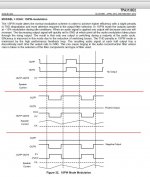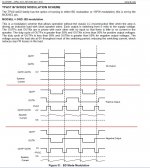Just thinking about if you had a full bridge class D and under no signal conditions, instead of each side switching up and down at 50% duty cycle but without reference to the other side, how would it be if both sides of the bridge were synced so that they both went up and down at the same time. For the signal to swing one direction the left side gets wider pulses and the right side narrower pulses, and vice versa for the opposite polarity output signal, but both PWMs centred on the same point. The upshot of all this is 1/ the output inductor would run way cooler because it would see a PWM level that is proportional to the audio level, not get hammered full blast even at no signal. 2/ the output HF ripple would be proportional to the audio signal level I think. One downside is there would be LOTS of common mode switching noise on the speaker leads that would have to be dealt with somehow.
Are there any amps that use this technique?
Are there any amps that use this technique?
All balanced bridge class D switching amplifiers are synced together, if they weren't, they would be unstable and oscillate at the frequency difference. That is how the FM amplifier works.
The duty cycle and pulse width must be the same for both halves of the output stage otherwise DC would be set up across the speaker terminals. At idle, the pulse widths are equal.
The duty cycle and pulse width must be the same for both halves of the output stage otherwise DC would be set up across the speaker terminals. At idle, the pulse widths are equal.
Attachments
I understand what you are saying but you seem to have missed my point. Let's assume we have a +/- 50VDC buss, 100V in total. With a conventional full-bridge class D amplifier, with zero audio signal output each half bridge would be going at 50% duty cycle, but opposite in phase so that the output inductor would have +/- 100V fed to it at maybe several hundred KHz.
The setup I am suggesting, with zero audio signal output both half bridges go up and down at the same time because they are in phase, not 180 deg out of phase. Therefore with no audio signal output there is no nett HF voltage fed to the output inductor. When we start to produce an audio output signal of a given polarity, one half bridge increases in duty cycle and the other half bridge decreases in duty cycle, both pulse trains being centre justified.
When an audio signal is produced, the output inductor would see double the switching frequency and a pulse width proportional to peak audio signal voltage.
The setup I am suggesting, with zero audio signal output both half bridges go up and down at the same time because they are in phase, not 180 deg out of phase. Therefore with no audio signal output there is no nett HF voltage fed to the output inductor. When we start to produce an audio output signal of a given polarity, one half bridge increases in duty cycle and the other half bridge decreases in duty cycle, both pulse trains being centre justified.
When an audio signal is produced, the output inductor would see double the switching frequency and a pulse width proportional to peak audio signal voltage.
Last edited:
...
The setup I am suggesting, with zero audio signal output both half bridges go up and down at the same time because they are in phase, not 180 deg out of phase. Therefore with no audio signal output there is no nett HF voltage fed to the output inductor. When we start to produce an audio output signal of a given polarity, one half bridge increases in duty cycle and the other half bridge decreases in duty cycle, both pulse trains being centre justified.
...
BD-modulation
All inductors see full swing in pwm...that is how it works.
1SPW works a little different...more efficient but higher distortion/noise.
Review the two modulation methods shown that are available for the TPA3116.
Attachments
Last edited:
^^ Yep, the second sheet. That's exactly what I was talking about. Gotta read up on that chip now. I wonder why this method is not more widely used?
Edit -> key word is "filterless".
class d filterless - Google Search
Edit -> key word is "filterless".
class d filterless - Google Search
Last edited:
Attachments
Last edited:


